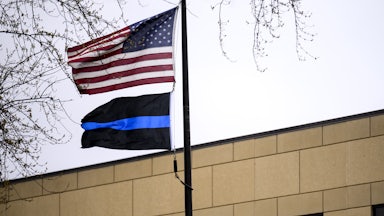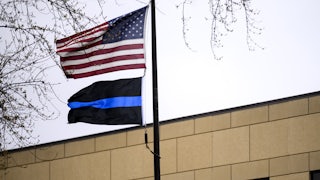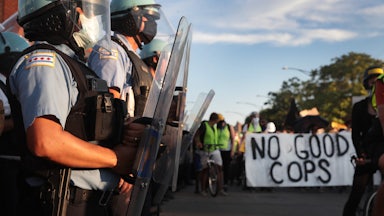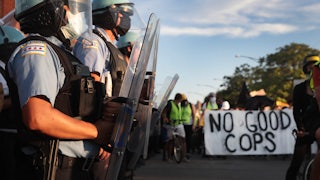On Tuesday, the National Fraternal Order of Police posted a graphic on Twitter. It bore the title “SKYROCKETING MURDER RATES” on a red banner and listed year-to-date increases in murder rates in seven major U.S. cities. The organization, which represents hundreds of thousands of police and police unions, wrote, “Any guesses of what these cities have in common? In addition to having some elected officials that don’t do their jobs, the leadership in all of these cities turned the keys over to the ‘Defund the Police’ mob.”
There are signs that crime is on the rise in some U.S. communities, especially homicides in major cities. Some have explicitly blamed this uptick on the protests and reforms that followed George Floyd’s death last May. Others have made the same claim in more subtle ways. Progressives pointed to the rise in poverty and hardship during the pandemic. Conservatives have begun blaming Democrats and the Biden administration for the shift. The real answer likely defies simple or casual description—and we probably won’t get it any time soon.
Any guesses of what these cities have in common?
— National Fraternal Order of Police (FOP) (@GLFOP) May 25, 2021
In addition to having some elected officials that don't do their jobs, the leadership in all of these cities turned the keys over to the "Defund the Police" mob. pic.twitter.com/rF5QLskXqE
The first sign that something is amiss here is the 800 percent year-to-date increase in homicides in Portland, Oregon, a city often denounced by conservatives for its public clashes over policing. The 800 percent increase in homicides sounds astronomical, but it’s because the absolute numbers are so low by U.S. standards: Oregon’s largest city went from three homicides during that period in 2020 to 27 homicides thus far this year. Other major cities have experienced more substantial surges in homicides since last year. But the year-to-date comparison is somewhat misleading when most of the country was under stay-at-home orders for the first half of 2020 because of the pandemic.
Note that the Fraternal Order of Police also took care not to link the rise in homicides explicitly to actual material declines in police budgets. That’s because some cities did not actually “defund the police” in any meaningful way. In Washington, D.C., for example, the City Council really did cut millions in police funding from Mayor Muriel Bowser’s proposed budget last year. But a local news analysis found that city officials had vastly oversold their efforts: Bowser’s plan had originally proposed a much larger increase in the police operating budget from the previous year, which accounted for most of the proposed reduction. The rest came from a City Council decision to shift school safety contracts to the local school budget, but that money would never have gone directly to city police officers in any event.
The New York City Council voted last June to cut $1 billion from the NYPD’s roughly $6 billion annual budget. Though the sum may seem substantial, its effects on city policing may be minimal. As in D.C., City Council members achieved most of the cut by shifting $400 million for school safety from the police budget to the school budget. The rest came from extending a city-wide hiring freeze to a single class of future NYPD officers and by shifting other ancillary municipal functions elsewhere. New York Representative Alexandria Ocasio-Cortez implicitly described the supposed cuts as “budget tricks” and “funny math.”
It’s hard to blame a rise in homicides on defunding the police if the police weren’t actually defunded. So what do we actually know about the uptick in crime? The most honest answer is: Not nearly enough. Unfortunately, the United States lacks a comprehensive or timely system for gathering crime statistics. The most frequently cited statistics in these debates are those compiled by the FBI, which in turn obtains them from more than 18,000 state, local, and tribal law enforcement agencies across the country. When people discuss national trends in homicides, violent crimes, or property crimes, this is usually the data set upon which they rely.
But these numbers are flawed in a few ways. Some shortcomings are inescapable: For example, not every crime that’s committed gets reported to the police. But other deficiencies are more conspicuous. National data collection isn’t mandatory, for instance, and roughly 2,000 agencies didn’t submit numbers to the FBI for the most recent set. Comparisons between jurisdictions are tricky because each state’s criminal code is different. What counts as aggravated assault in one place might be ordinary assault in another.
Perhaps the biggest weakness of the FBI’s crime statistics is time itself. The federal government provides a dizzying array of statistics on a regular basis. It’s fairly easy to track monthly or sometimes even weekly changes in employment, inflation, wages, housing permits, factory inventories, imports and exports, and much more with official statistics. The FBI, by comparison, releases national crime statistics in full on an annual basis and with a significant delay. The bureau released its 2019 figures in September 2020, meaning that we won’t have a clearer picture about national crime rates at this moment for another 15 months.
Imagine trying to analyze the health of the American economy right now with unemployment numbers from February 2020. This epistemic void is often filled by local news reports and internet message boards, which can give a false impression of crime levels in a given community. It also enables bad-faith observers to cherry-pick the most dire figures from cities and states across the country and extrapolate from there.
Perhaps the best survey of what’s happening with murders right now comes from the Center for Criminal Justice, which has issued regular reports on crime rates during Covid-19. Its most recent report in March draws upon data from more than two dozen major U.S. cities where data was available. It found a substantial increase in homicides in those cities beyond the usual year-to-year fluctuations. “Double-digit percentage increases in homicide above and beyond normal seasonal changes are deeply troubling and suggest that the homicide rise of 2020 has continued into early 2021,” the report said. “As we noted in our year-end report, the historic (30%) rise in homicide rates was likely attributable to the pandemic, social unrest, and other factors that combined to create a ‘perfect storm’ of circumstances.”
Any increase in homicides is a tragedy, which makes untangling the reasons behind it all the more important. “Broadly, I would guess the reason is multicausal,” Ames Grawert, a senior counsel at the Brennan Center for Justice who works on criminal justice issues, told me. He suggested that possible factors behind rises in homicides could include social and community breakdowns because of the pandemic, as well as increased poverty at the community level. Grawert also pointed to a breakdown in police-community relations as a potential factor, especially after the George Floyd protests.
Many of these factors can be traced to the pandemic itself. If they’re a driving factor behind crime increases, they may prove to be transitory. “Another thing that I think is probably an understated but really important factor is, there have been a lot of places where community anti-violence work has been really effective [at lowering homicide rates],” Grawert told me. “That work is fundamentally undoable in the pandemic in many ways. So if you aren’t able to do that work, you might see a retreat of that important work correlating with an increase in homicides.”
Some scholars, such as Princeton University sociologist Patrick Sharkey, have reached similar conclusions. “My argument is that in areas where communities go through periods of disinvestment and where institutions break down, people feel like they’re on their own,” Sharkey told The Atlantic’s Derek Thompson in an interview in March. “This creates conditions where violence becomes more likely. As a place becomes more violent, people change their behavior. They become more likely to interpret uncertainty in an aggressive way, more likely to carry a weapon, more likely to act quickly or first if they feel threatened. This is how the presence of violence creates more violence. This cascading effect, where violence begets violence, has been reinforced in the past year.”
The Atlantic published Sharkey’s interview with a headline declaring that the Great Crime Decline was “over” and claiming that Americans could no longer say they live in the safest period in the nation’s history. Depending on how one defines periods in American history, this is an overstatement. In New York City, for instance, local officials recorded 462 murders in 2020. That’s far below the city’s record of 2,245 murders in 1990, when the city also had one million fewer people living in it. (City crime statistics typically exclude the victims of the September 11 attacks.) The U.S. would have a long way to go before returning to the bad old days.
The Center for Criminal Justice report also complicates the hunt for easy answers to this problem. Though it doesn’t provide a definitive nationwide look at homicide rates, it did find that the surge in homicides appears to have begun in late 2019. That would suggest that some of the increase in homicides can’t be entirely attributed to the pandemic, or to social justice movements, or other factors that first cropped up in 2020. This lack of firm footing isn’t entirely surprising: There still isn’t a scholarly consensus on what exactly caused the Great Crime Decline in the first place.
In the absence of simple explanations, there’s a tendency to reflexively blame local leaders. Most of the scorn has been heaped upon reform-minded prosecutors like Philadelphia’s Larry Krasner, San Francisco’s Chesa Boudin, and Los Angeles’s George Gascon by their respective law enforcement communities and some citizens. It’s unclear whether these policies are tangibly related to a broad increase in crime. Some critics have tried to blame Boudin’s policies in San Francisco for the city’s recent surge in burglaries, for instance. But that surge reportedly came alongside a sharp drop in thefts targeting tourists and local businesses during the pandemic. That could indicate that the rise in burglaries reflects a change of tactics by perennial thieves instead of a purely secular increase in criminal behavior or a broader policy effect.
That’s not to say that decisions by local officials can’t play a role here. There are reports that some San Francisco cops have told residents they wouldn’t investigate some crimes because they think the district attorney won’t prosecute them, a claim acknowledged by both Boudin and police chief Bill Scott. Police unions spent heavily to oppose Boudin’s candidacy for district attorney in 2018 and have continued running negative ads against him since he took office. The San Francisco Chronicle reported that the city’s clearance rate for burglaries was below 10 percent, meaning that police don’t make arrests in more than nine out of 10 burglaries in San Francisco. Without arrests, there are no cases for Boudin to prosecute or not prosecute.
It’s still too soon to tell what exactly the broader political impact of the homicide spike will be. Republicans have latched on to the possibility of using it against Democrats in next year’s midterm elections. Whether law and order politics will have the same electoral valence as they did in the 1980s and 1990s remains to be seen. Many national observers wrote that the Philadelphia district attorney’s election this month would be a referendum of sorts on whether criminal justice reforms could survive the crucible of higher crime rates. Krasner ultimately won by a healthy margin. It’s just one city and just one election, of course. But if he had lost, the narrative on crime and reform would have been far different.
Fly-by-night pundits and self-serving critics of reform within the law enforcement community ultimately argue that there’s a binary choice at work here: You can live under America’s system of intense policing and intense punishment, or you can live under rising homicide rates and surging crimes. All of the available evidence suggests that this isn’t how the world actually works. And Krasner’s victory suggests that at least some communities don’t see it that way, either.








